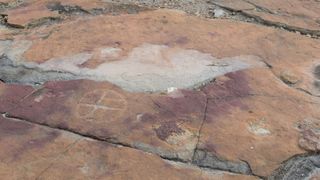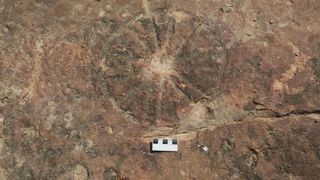9,000-year-old rock art discovered among dinosaur footprints in Brazil
Ancient hunter-gatherers created rock art next to dinosaur footprints in what is now Brazil.

As far back as 9,400 years ago, hunter-gatherers in what is now Brazil created dozens of stunning rock-art designs next to the fossilized footprints of dinosaurs, a new study finds.
Researchers described the petroglyphs and dinosaur tracks, which date to the Cretaceous period (145 million to 66 million years ago), in a study published March 19 in the journal Scientific Reports. They think ancient humans purposefully put the rock art next to the dinosaurs' prints, as many of the petroglyphs are a mere 2 to 4 inches (5 to 10 centimeters) from the fossilized marks and some of the glyphs appear to be illustrations of the prints.
"The individuals who crafted the petroglyphs were acutely aware of the footprints, likely selecting the location precisely because of them," study first author Leonardo Troiano, an archaeologist from Brazil's National Institute of Historic and Artistic Heritage, told Live Science "It would have been impossible to overlook their presence."
The archaeological site, known as Serrote do Letreiro (Portuguese for "Signpost Hill"), is about 7 miles (11 kilometers) from the urban center of Sousa municipality in the northeastern state of Paraíba. It's close to the Valley of the Dinosaurs, a conservation area renowned for its hundreds of fossilized dinosaur footprints.
Researchers have known about the fossilized dinosaur prints in the area since the early 20th century, but the rock art there has been only briefly mentioned over the years, the new study reported. While there was already knowledge of at least one ancient engraving by the Kiriri, the main Indigenous group in the hinterlands of northeast Brazil, the proximity between the petroglyphs and the dinosaur trackways had never been documented, Troiano said.
Related: 2,000-year-old carvings of celestial bodies and animals discovered on rocky cliffs in Brazil

Troiano and colleagues did the study with a group of middle-school students who went to the site in 2023. In addition to learning about paleontology and archaeology, the students helped photograph the fieldwork.
Sign up for the Live Science daily newsletter now
Get the world’s most fascinating discoveries delivered straight to your inbox.
The team noted that the tracks belong to various dinosaur types, such as meat-eating theropods, long-necked sauropods, and two-legged ornithopods, including iguanodontian dinosaurs. The resemblance of the footprints to those of the emu-like rhea (Rhea americana), the largest living bird in Brazil, may have made it easier for ancient people to recognize and interpret these fossil remains, the study authors suggested.

The petroglyphs, largely carvings of circles filled with lines and other geometric strokes, are attributed to humans who lived in the region anywhere between 9,400 and 2,620 years ago. "They were small seminomadic groups of hunters and gatherers who lived in society and used objects made from stones," Troiano said.



The researchers didn't find any organic remains that would have made radiocarbon dating possible, so "we compared the art to archaeological sites in the region with similar or identical rock art," Troiano said. For instance, petroglyphs in sites such as Pedra do Alexandre, approximately 120 miles (200 km) west of Serrote do Letreiro, date as far back as about 9,400 years ago, based on radiocarbon analyses of human burials.
Ancient humans made the newly described carvings with two techniques: perforation and scraping, the researchers found.
"Perforation involves using a kind of stone hammer to create depressions on the surface, resembling stippling, while scraping entails rubbing a stone against the surface until it forms the desired engraving," Troiano said. In some instances, both techniques were combined to enhance visibility and depth.
Lobato Felizola is a contributing writer for Live Science. He holds a master's degree in communication sciences, contemporary culture and new technologies from NOVA University of Lisbon, and journalism from Catholic University of Brasília. His work covers everything from archaeology to energy and sustainability, with a special interest in the climate crisis and the environment, such as biodiversity, land-use change and community-based solutions. Lobato’s work has appeared in Yes! Magazine, Atlas Obscura, Earth Island Journal, among others. In Brazil, his previous positions include reporting at Correio Braziliense newspaper and producing at TV Brasília.
-
akiprev "dinosaur tracks, which date to the Cretaceous period (145 million to 66 million years ago)."Reply
How these dinos' tracks weren't obliterated by erosion in mere thousands years is beyond me. -
dglens That's because they've only been there thousands of years. Why can't they see the obvious... That the two species coexisted.Reply -
akiprev Reply
But how can eminent scientists and publications publish such a nonsense? It's a matter of common sense, let alone the established rates of the rock erosion, that such imprints can't last any so long.dglens said:That's because they've only been there thousands of years. Why can't they see the obvious... That the two species coexisted. -
nino82 Reply
I am not a geologist, and so I can't prove you wrong, but I would think the dino tracks would have to be older since they would have been imprinted/made on softer soil or mud which then had to harden over some time period before the humans could paint on the spot where the prints were made. I don't think a human could paint directly on soft soil or mud right after an animal made a foot print, but only on a hard surface like a rock, which would take years for the mud to harden into first. Based on a quick google search, the footprints were preserved because sediments and other materials fell on the footprints and were able to preserve them and protect them from erosion (until eventually the overlaying sediment did erode away, more recently, to reveal the foot prints).dglens said:That's because they've only been there thousands of years. Why can't they see the obvious... That the two species coexisted. -
akiprev Reply
Hm, I can't imagine that the overlying sediments could have eroded leaving these tracks discernible. Of course they would have coalesced with the underlying surface in any longer tracts of time.nino82 said:Based on a quick google search, the footprints were preserved because sediments and other materials fell on the footprints and were able to preserve them and protect them from erosion (until eventually the overlaying sediment did erode away, more recently, to reveal the foot prints). -
nino82 Reply
You are probably right in 99% of cases, but maybe in a small fraction of situations the sediment doesn't alter the footprint, if it is made of a more erodible material than what the footprint is made out of, such that the footprint remains after the overlaying sediment gets eroded away. Similar to how you can see tall rock mounds or boulders sitting on top of narrow pieces of rock, due to the surrounding rocks/sediment eroding away (like the rock at Kannesteinen Vågsøy, Norway).akiprev said:Hm, I can't imagine that the overlying sediments could have eroded leaving these tracks discernible. Of course they would have coalesced with the underlying surface in any longer tracts of time. -
diversemark Replynino82 said:I am not a geologist, and so I can't prove you wrong, but I would think the dino tracks would have to be older since they would have been imprinted/made on softer soil or mud which then had to harden over some time period before the humans could paint on the spot where the prints were made. I don't think a human could paint directly on soft soil or mud right after an animal made a foot print, but only on a hard surface like a rock, which would take years for the mud to harden into first. Based on a quick google search, the footprints were preserved because sediments and other materials fell on the footprints and were able to preserve them and protect them from erosion (until eventually the overlaying sediment did erode away, more recently, to reveal the foot prints).
You're correct that dinosaur tracks are typically preserved due to sedimentation and subsequent hardening of the substrate. When dinosaurs walked on soft mud or sediment, their footprints would leave impressions that, over time, could be filled with additional sediment or minerals, eventually solidifying into rock. This process, known as fossilization, can take thousands to millions of years depending on the specific conditions. -
akiprev Reply
I still can't imagine how these prints could be discernible after the sediments allegedly eroded away. This rock doesn't look like aver having any subsequent sediment on it. Even otherwise, the meeting surfaces clearly wouldn't retain their reliefs.nino82 said:You are probably right in 99% of cases, but maybe in a small fraction of situations the sediment doesn't alter the footprint, if it is made of a more erodible material than what the footprint is made out of, such that the footprint remains after the overlaying sediment gets eroded away. Similar to how you can see tall rock mounds or boulders sitting on top of narrow pieces of rock, due to the surrounding rocks/sediment eroding away (like the rock at Kannesteinen Vågsøy, Norway).
Most Popular



